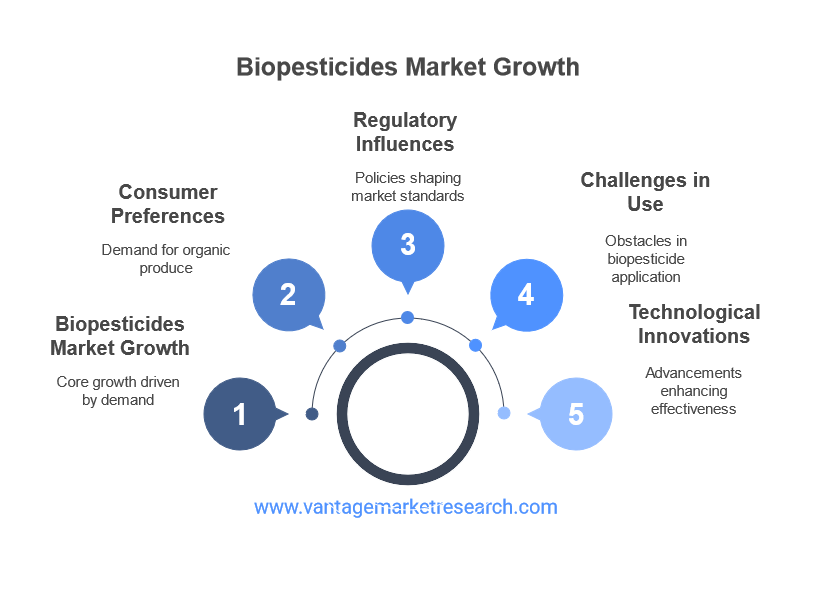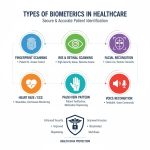The Growing Landscape of the Biopesticides Market
The biopesticides market is experiencing a significant transformation, driven by increasing consumer awareness and demand for organic produce. With a valuation of USD 5.75 billion in 2022, the market is projected to reach USD 17.57 billion by 2030, exhibiting a remarkable CAGR of 15.00%. The Vantage Market Research delves into the current state of the Biopesticides Market, consumer preferences for organic foods, regulatory influences, challenges in biopesticide use, technological innovations, and future market opportunities.

Current State of the Biopesticides Market
The biopesticides market is on an upward trajectory, fueled by a growing awareness of the adverse effects of chemical pesticides on health and the environment. Analysts predict that the market will grow significantly, reaching USD 17.57 billion by 2030. Key regions driving this growth include North America, Europe, and Asia-Pacific, where organic farming practices are becoming more prevalent.
In North America, the demand for biopesticides is bolstered by stringent regulations against harmful chemicals, prompting farmers to seek safer alternatives. Europe follows suit, with a strong emphasis on sustainability and environmental protection, leading to increased adoption of biopesticides. Meanwhile, Asia-Pacific is witnessing a surge in agricultural investments, further enhancing the market’s growth potential.
Several factors are driving the expansion of the biopesticides market. The increasing prevalence of organic farming, coupled with consumer demand for chemical-free produce, is a primary catalyst. Additionally, advancements in agro-product technologies, such as the development of plant extract-based solutions, are enhancing the efficacy of biopesticides. However, challenges such as poor shelf-life and inconsistent performance may hinder market growth.
Consumer Preferences for Organic Foods
The rising demand for organic produce is reshaping the agricultural landscape, with consumers increasingly prioritizing health and environmental considerations. As awareness of the potential risks associated with chemical residues in food grows, consumers are gravitating towards organic options, which are perceived as safer and healthier.
This shift in consumer preferences is directly impacting the adoption of biopesticides. Farmers are recognizing the need to align their practices with consumer expectations, leading to a greater reliance on biopesticides as a means of pest control. The non-toxic properties of biopesticides not only address health concerns but also contribute to improved soil fertility, making them an attractive option for organic farmers.
Moreover, the growing availability of educational resources on biopesticides is enhancing public knowledge and acceptance. As consumers become more informed about the benefits of biopesticides, their demand for organic produce is likely to continue rising, further driving the growth of the biopesticides market.
Regulatory Influences on Biopesticides
Regulatory frameworks play a crucial role in shaping the biopesticides market. Recent updates in pesticide regulations are increasingly favoring sustainable practices, encouraging the use of biopesticides over synthetic alternatives. Governments worldwide are recognizing the importance of promoting environmentally friendly agricultural practices, leading to increased support for biopesticides.
In many regions, the banning of certain synthetic pesticides has created a favorable environment for biopesticides. As farmers seek alternatives to comply with regulations, the demand for biopesticides is expected to rise. Additionally, government initiatives aimed at promoting organic farming and sustainable agriculture are further enhancing the market’s growth prospects.
However, navigating the regulatory landscape can be challenging for biopesticide manufacturers. Ensuring compliance with evolving regulations requires significant investment in research and development, which may pose a barrier to entry for smaller companies. Nevertheless, the overall trend towards stricter regulations on synthetic pesticides is likely to benefit the biopesticides market in the long run.
Challenges in Biopesticide Use
Despite the promising growth of the biopesticides market, several challenges hinder their widespread adoption. One significant limitation is the efficacy and speed of biopesticides compared to traditional chemical pesticides. Farmers often require immediate results in pest control, and the slower action of biopesticides can be a deterrent.
Resistance from traditional farming practices also poses a challenge. Many farmers are accustomed to using synthetic pesticides and may be hesitant to switch to biopesticides due to concerns about their effectiveness. Additionally, environmental sensitivity issues, such as the potential impact of biopesticides on non-target organisms, can create apprehension among farmers.
To overcome these challenges, ongoing research and development are essential. Improving the formulation and delivery methods of biopesticides can enhance their efficacy and appeal to farmers. Education and outreach programs can also help bridge the gap between traditional practices and sustainable alternatives.
Technological Innovations in Biopesticides
Technological advancements are playing a pivotal role in the evolution of the biopesticides market. Precision agriculture, which utilizes data-driven approaches to optimize farming practices, is enhancing the effectiveness of biopesticides. By integrating biopesticides into precision agriculture strategies, farmers can achieve more targeted pest control, reducing the need for chemical interventions.
Advancements in microbial biopesticides are also noteworthy. Researchers are exploring the potential of beneficial microorganisms to combat pests and diseases, offering a sustainable alternative to chemical pesticides. These innovations not only improve the efficacy of biopesticides but also contribute to soil health and biodiversity.
Furthermore, the integration of digital farming solutions is revolutionizing the agricultural sector. Farmers can leverage technology to monitor pest populations, assess crop health, and make informed decisions about biopesticide applications. This synergy between technology and biopesticides is expected to drive market growth and enhance sustainability in agriculture.
Market Opportunities and Future Prospects
The future of the biopesticides market is bright, with numerous opportunities for growth. Companies are expanding their product offerings to meet the diverse needs of farmers, including the development of new biopesticide formulations and combinations. This diversification is essential for capturing market share and addressing specific pest challenges.
Developing regions present significant growth potential for the biopesticides market. As agricultural practices evolve and the demand for sustainable solutions increases, companies that invest in these markets are likely to reap substantial rewards. Collaborations across the agricultural sector, including partnerships with research institutions and government agencies, can further enhance market opportunities.
In conclusion, the biopesticides market is poised for substantial growth, driven by consumer preferences for organic foods, regulatory influences, technological innovations, and emerging market opportunities. While challenges remain, the overall trajectory of the market suggests a promising future for biopesticides as a sustainable alternative to traditional chemical pesticides.
FAQs
- What factors are driving the growth of the Global Biopesticides Market?
- How is the Biopesticides Market expected to evolve by 2030?
- What is the significance of organic food trends for the Biopesticides Market?
- What does the CAGR of 15.00% imply for the future of biopesticides?
![[Market Research Reports] – Research Google News Blog | VMR.Biz](https://www.vmr.biz/wp-content/uploads/2022/12/logo-removebg-preview.png)











